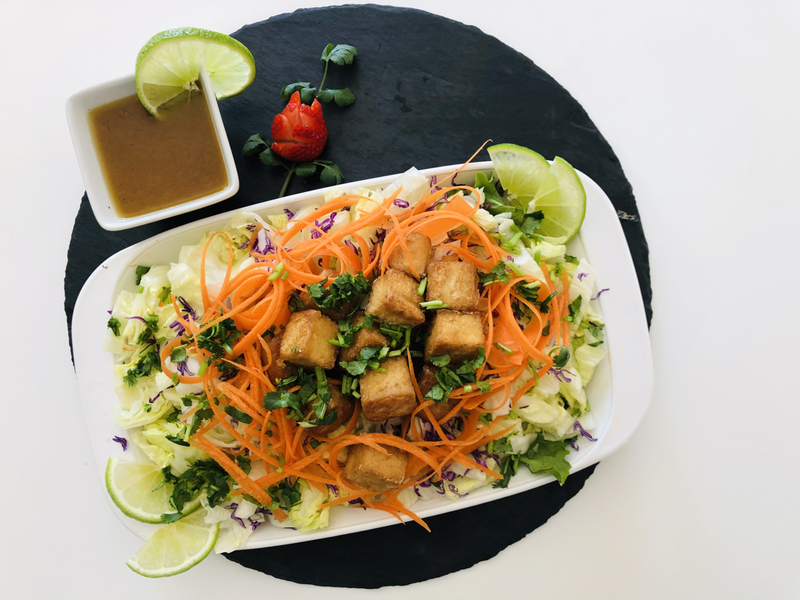Day 20: Legumes as Protein Source
Legumes are very nutritious and high in protein and fiber, rich in B vitamins, iron, copper, magnesium, manganese, zinc, and phosphorous. Common legumes include beans like soy, kidney beans, cannellini, black-eyed peas, chickpeas, lentils, mung beans (monggo), and surprise, peanuts!
Studies have shown that eating legumes can help control blood glucose levels and manage cholesterol and triglyceride levels. It even helps in managing blood pressure. This is attributed to the legume’s potassium, magnesium, and fiber content. Eating legumes may also help with weight management because the carbohydrate in the legume is slowly digested, and the fiber makes one feel full.
The best way to have legumes incorporated into your diet is to have canned beans and dry beans in your pantry. Lentil is the fastest legume to cook (only 20 min). To have a ready supply, you can also soak and cook beans in a big batch and freeze it.
Chickpeas can be pureed and make a good vegetable or pita bread dip. Have you ever heard of hummus? You can add garlic, smoked paprika, tahini, lemon, extra virgin olive oil, and some roasted peppers and blend.
Lentils are commonly used in Indian-style sauces. Common spices you can use are curry, turmeric, cumin, and garam masala.
Legumes also make wonderful sprouts. Just soak overnight, then spread on a tray and cover with a wet paper towel and leave in a dark place for 2-3 days. You can use it for salads.
Soup and salad recipes abound on the internet for legumes. It’s so easy to incorporate into your diet and score a MedDiet point.
One very interesting thing about legumes is that planting them alongside a corn and squash (commonly called the 3-sister trio) provides benefits to the soil. The legume houses the nitrogen-fixing bacteria in its root nodules and enriches the soil in the process. The corn, which consumes much nitrogen, benefits from this, and in return, it serves as the pole for the legume to crawl on. The squash leaves provide shade to the soil and keep the roots from drying.
I wonder if I can grow these in my backyard. But I can definitely sprout some beans.
What’s your favorite legume? Share some recipes and your methods of sprouting beans.
Studies have shown that eating legumes can help control blood glucose levels and manage cholesterol and triglyceride levels. It even helps in managing blood pressure. This is attributed to the legume’s potassium, magnesium, and fiber content. Eating legumes may also help with weight management because the carbohydrate in the legume is slowly digested, and the fiber makes one feel full.
The best way to have legumes incorporated into your diet is to have canned beans and dry beans in your pantry. Lentil is the fastest legume to cook (only 20 min). To have a ready supply, you can also soak and cook beans in a big batch and freeze it.
Chickpeas can be pureed and make a good vegetable or pita bread dip. Have you ever heard of hummus? You can add garlic, smoked paprika, tahini, lemon, extra virgin olive oil, and some roasted peppers and blend.
Lentils are commonly used in Indian-style sauces. Common spices you can use are curry, turmeric, cumin, and garam masala.
Legumes also make wonderful sprouts. Just soak overnight, then spread on a tray and cover with a wet paper towel and leave in a dark place for 2-3 days. You can use it for salads.
Soup and salad recipes abound on the internet for legumes. It’s so easy to incorporate into your diet and score a MedDiet point.
One very interesting thing about legumes is that planting them alongside a corn and squash (commonly called the 3-sister trio) provides benefits to the soil. The legume houses the nitrogen-fixing bacteria in its root nodules and enriches the soil in the process. The corn, which consumes much nitrogen, benefits from this, and in return, it serves as the pole for the legume to crawl on. The squash leaves provide shade to the soil and keep the roots from drying.
I wonder if I can grow these in my backyard. But I can definitely sprout some beans.
What’s your favorite legume? Share some recipes and your methods of sprouting beans.
Watch the Week 3 summary video on protein to wrap up your protein challenge.
PROTEIN CHALLENGE #6
Let’s get cooking! Tofu comes from soybeans, one of the plant-based protein sources that provides complete essential amino acids. Below is a simple recipe that you can make. The tofu is crisp tender and can be eaten as an appetizer, a side dish, a main entre served with rice and stir fry vegetables or as a topping to an Asian salad or miso soup. Enjoy!









